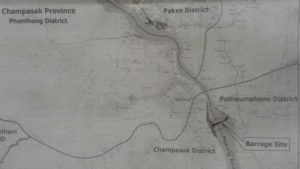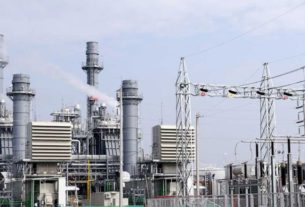
Thailand’s Charoen Energy and Water Asia Company Plans to Build Phoug noi dam on Mekong River south of Pakse in Laos
A Thai hydropower company has plans to build what would be Laos’ sixth large-scale Mekong river dam, the latest cog in Laos’ ambitious plan to become the “battery of Southeast Asia.”
FACT-SHEET OF MEKONG MAINSTREAM DAMS
The Thailand-based Charoen Energy and Water Asia Co. Ltd. (CEWA) presented to Lao authorities the results of studies related to the Phoug noi dam (formerly Lat Sua) project at a meeting in Pakse city on Feb. 11.
According to the plans, the Phoug noi dam would be located in Champassak province, 10 kilometers (6.2 miles) south of Pakse and about 100 kilometers (62 miles) north of the Don Sahong dam, which recently began operations.
“The company presented the results of the initial feasibility study and the environmental impact assessment of the proposed dam at the meeting,” an official at the Champassak Provincial Administration Office told Radio Free Asia, a sister entity of BenarNews, on Wednesday.
“Right now, they have not yet built anything and have many more steps to go through, so construction will not begin any time soon,” the official said.
The official said he did not know when the Lao government would notify the Mekong River Commission about the project, a mandatory step for new Mekong river developments that would begin a six-month prior consultation process that would include an impact assessment for affected neighboring countries.
“The initial studies [presented at the Feb. 11 meeting] focused on the impact on local people, but not in much detail. If [the developer and Laos’ government] go ahead with this project, they will need more details on how it would impact people who live downstream from the dam,” the official said.
The studies showed that the Phoug noi dam would affect more than 200 hectares (500 acres) of land, home to 88 villages in seven districts. The most affected village would be Khon Ken village, where 811 residents reside in 142 households. Details of construction costs and power purchase agreements have not yet been revealed.

A CEWA representative said the company has completed designs for the dam as well as the initial studies into the environmental and social impacts of the project.
Residents said they are concerned about the potential impact.
“Why is the Lao government building so many dams?” a resident of Champassak province’s Champassak district asked.
“We already have too many. If we build more, droughts will be more severe and the water level on the Mekong will get lower and lower,” the resident said.
A village chief in Sanasomboun district, an area which would be greatly affected, said none in the village had heard anything about the development project.
Stakeholders urge Laos to share more information
Meanwhile at northern Laos’ Xayaburi dam, which began commercial operations in October, government officials and stakeholders toured the facilities Thursday and recommended that the dam’s developer share information about its operation with the lower Mekong countries.
The 50-person tour included NGO representatives, researchers, journalists and specialists from the MRC Secretariat.
According to a report on the MRC website, the tour included presentations by the dam’s developer on the plant’s design, with visits to fish passes, flushing gates, and views of water levels both up and downstream.
“We want the site visit to speak for itself regarding the situation of low flows and drought in the Mekong,” said Anoulak Kittikhoun, Chief Strategy and Partnership Officer at the MRC Secretariat and leader of the tour.
“We’d like our stakeholders to see the dam and its operation with their own eyes and pose questions to the developer so that they can form their own assessment.”
The visitors said they were appreciative of the developer’s openness, but they expressed their hope that the company would share with the MRC Secretariat data on the dam’s operation including water flow, sediment transport and migration.
“Observed data and information on sediment and fish migration above and below the dam as well as on energy generation should be shared,” said Nhan Quang Nguyen, representing a Vietnamese NGO, the Centre for Promotion of Integrated Water Resources Management.
“Transparent and timely sharing of this information could help the people and relevant authorities make better planning,” he said.
Knut Sierotzki, an engineering consultant for a Finnish company that assists the Xayaburi power company tried to quell concerns about the dam storing excessive amounts of water.
“There is no storing of water – what flows in will eventually flow out,” Sierotzki said.
“The flow regime of the river is not changed. The inflow water is constantly released either through the turbines or spillway,” he said.
He also said the discharge during this dry season was about 50 percent higher than that of the 2003-2004 dry year which saw the water flowing out between 800 and 1,000 cubic meters per second.
But Patchara Jaturakomol of Thailand’s Kasetsart University said Sierotzki’s claim illustrates why the data needs to be shared. If the developer were to make the official data public, the data could “speak for itself,” she said.
Laos has built dozens of hydropower dams on the Mekong and its tributaries, hoping to export the electricity they to other countries in the region. It is preparing to build scores more dams in the years ahead.
Though the Lao government sees power generation as a way to boost the country’s economy, the projects are controversial because of their environmental impact, displacement of villagers, and questionable financial arrangements.
Source: https://www.benarnews.org/english/news/thai/new-dam-02212020172543.html


